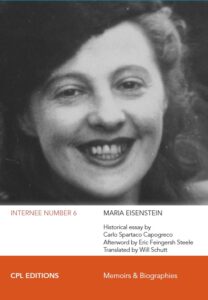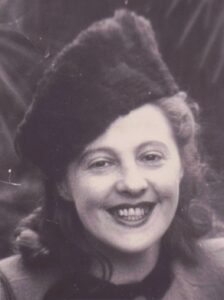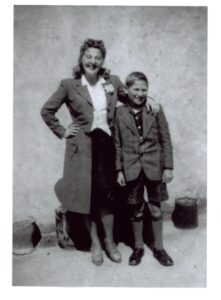Internee Number 6
By Maria Eisenstein, Curated by Carlo Spartaco Capogreco
Afterword by Eric Feingersh Steele
Translated by Will Schutt
Published when the war was still raging north of Rome, Internee Number 6 is the first memoir of the fascist internment of foreign Jews. Although known to scholars, for decades it has remained buried in a few bibliographies, while nothing was known of its author.
Maria Eisenstein’s authorship is elusive and ironic, worldly, and unapologetic. She wrote beautifully in Italian to the point that her diary, first published after she crossed the Allied line and fled South, was once considered fiction. For many years, the author’s fate remained the topic of speculation. In 1989, historian Carlo Spartaco Capogreco identified her and traced her story.
Eisenstein’s diary is an extraordinary document on the sudden incarceration of “foreign Jewish civilians” in fascist Italy. It paints a subtle fresco of the cultural and psychological atmosphere in which wellmeaning men and women performed the ideals of morality, strength, and valor that gave Fascism its foundation.
About the Author
Little is known about Maria Moldauer’s life prior to her arrival in Florence in the early 1930s and after her departure from Italy in 1948. She was born in Vienna to Polish-Jewish parents in 1915 and moved to Italy to study literature at the University of Florence, where she wrote her thesis on Goethe’s Faust.
After graduating, she moved to Catania, Sicily, with her lover, Franco. In Catania, she ran in literary circles and befriended the writer Vitaliano Brancati.
On June 10, 1940, when Mussolini ordered the arrest of all Jews who did not have or had been stripped of Italian citizenship, Moldauer was immediately incarcerated and later sent to the women’s concentration camp in Lanciano, Abruzzo. She spent the following three years in various places of confinement.
While interned in Guardiagrele, Abruzzo, she met the Romanian internee Samuel Eisenstein. The two were married on February 4, 1942, by the Rabbi of Ancona, Elio Toaff.
The couple was once again transferred to surveilled confinement in Lanciano. After the armistice, on September 8, 1943, they fled to the mountains and planned to reach the front and the southern regions then controlled by the Allies. In the mountains they met other fugitives, including the Italian-Cuban writer Alba De Céspedes and her husband Franco Bounous, who were also traveling south. The two couples formed a close bond and managed to reach Bari, where they were employed by the Allies’ Psychological Warfare Branch. Moldauer began collaborating with De Céspedes on her programs for Radio Bari.
As the front advanced, the two couples moved to Naples and became active members of the early post-war intellectual circles then trying to rebuild Italian culture after two decades of fascism. They continued on to Rome, where they settled after the liberation in June 1944. It must have been in Naples that Moldauer began to gather her notes into what would become her chronicle of the war years, Internee Number 6.
In Rome she reunited with the translator and literary scholar Gabriella Bemporad, whom she had known since her days in Florence, as well as with Vitaliano Brancati. The Eisensteins frequented the home of Franco and Mauro Lucentini, where intellectuals and writers from all walks of life mingled in liberated Rome.
Moldauer also collaborated with De Céspedes on her new magazine Mercurio and began to work with Rome’s Jewish community assisting survivors and their families. Moldauer showed the manuscript of Internee Number 6 to Donatello De Luigi, whose publishing house was the first to open in Rome after the arrival of the Allies. De Luigi consulted with Irene Brin, a journalist and cultural organizer who had successfully navigated the transition out of fascism. Together they decided to publish the book, which would finally come out in August 1944.
In 1948 Maria and Samuel Eisenstein received their visas for the United States. They left on separate ships and parted ways shortly after their arrival. Both settled in California, where the scholar Carlo Spartaco Capogreco met Samuel in 1993. Maria died in 1994, shortly before Samuel was finally able to locate her.

Author : Maria Eisenstein, Curated by Carlo Spartaco Capogreco, Afterword by Eric Feingersh Steele
Translator: Will Schutt
Title : Internee Number 6
Year : 2024
Series : Memoirs
Paperback – ISBN 978-1-941046-34-0
Ebook: $9
Price paperback: $20
Publication date: June 1st, 2024.
It is sad and tragically ironic that my mother missed the republishing of her book by one year. In fact, in 1994, fifty years after she wrote it, the book was reprinted. I don’t know whether it was the bad sort of fortune that would visit without invitation at times in her life, if the publisher might have made a greater effort to locate her, being that she was still alive. Or if, perhaps, having changed her name to Steele interfered with tracking her down. I may never know, and she certainly won’t.
The renewed interest in her work would have brought her joy and validation. It would have been a great gift in her final year to know that, at last, there was a good chance the book would be read by a larger audience as the initial print run, in 1944, must have been quite small. Even if I were not her son, I would find that sad. Indeed, fate was cruel at times to my mother, but it also brought her joy. There is a certain “joy” in surviving but there is a deeper fulfillment from life, which she undoubtedly experienced. It was a theme that went through her life. Stretches of dark followed by light: somehow, she went on to thrive.
That is why I want her readers to know that, although I am her son, I should not be the one writing this attempt at an afterword and reflection. Maria Ludwika Moldauer Eisenstein Feingersh Steele should be writing this. It would probably be Maria L. Steele. L’Internata Numero 6 was, of course, about a significant chapter in her life and a significant chapter in world history. She should be the one to write about the other chapters in her story. However, being at the wrong place at the wrong time or never being at the right place at the right time plagued her, as I imagine did many who, like her, were refugees.
— From the afterword by Eric Feingersh Steele, Maria’s son.




